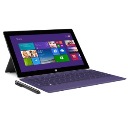For lawyers, there may be an advantage to choosing Windows-based tablets if you heavily use Microsoft tools such as its Office Suite.
Note: The article below, written by Marcus Bluestein, was originally published on October 4th, 2013 in Law Technology News. It is reprinted here with permission. Please visit Law Technology News to subscribe and read more from the legal technology community.
Imagine this scenario. You arrive at work and walk into your office, where you have a typical modern setup – laptop, dual monitors, keyboard, and mouse. You open your briefcase and remove your laptop, snap it into the docking station, and resume where you left off from the train. You have Outlook running on your second screen to your left. Word and Excel are displayed on your main monitor. You take advantage of the laptop screen and use it for your Lync conversations and meetings. You like this dashboard view. It gives you a lot of flexibility and reduces the amount of time you need to sort through application windows.
It is now mid-morning and you need to join a meeting in the conference room. You undock your laptop and bring it with you. Lync starts the meeting and you redirect the call to the conference room speaker phone. You are also sharing your PowerPoint presentation with the participants so you can collaborate on it. There are four people in the meeting – you, and another in the room, and two people in remote locations. As the meeting progresses you decide that you want to get additional feedback on the presentation, and invite three more people into the conference room to review it. To get the full effect, you decide to show the presentation on the 80-inch screen monitor in the room. Quickly and simply, you connect wirelessly to the monitor and put PowerPoint into presentation mode. In under 30 seconds, without getting up or plugging any cables in, the people in the room are able to see your presentation on the big screen. The slide deck and notes are still available on your laptop for you to reference.
We have seen many of our clients working this way for years – and we are now seeing clients express their desire to take this technology-enhanced style of work on the road.
Picture this conclusion to the above scene: After the meeting, you need to give the presentation to a client downtown. On the subway you review the presentation for a final run through on your touch-screen tablet. You notice a few additional changes that you want to make, and make edits while standing. In addition, you decide that you want to include a video related to the project on one of the slides and do so. Feeling confident that the presentation is ready, you read emails on your tablet until you get to the client’s office.
The presentation goes well. The client is happy. As the work day draws to a close, you head home. On the train, you pull out your tablet and turn on your favorite music. In Outlook, you finish reading and replying to your emails. Once that is done, you start reading the rest of the newspaper on the tablet. With 20 minutes left on your train ride, you play Angry Birds on your tablet. When you get home, you sit on the couch with the family and continue to use your tablet for work and pleasure.
This scenario seems typical of today, or, at least, like it should be – considering how many options there are for mobile devices. However, you have probably already encountered the limitations and nuances that make this style of work more possible for some than for others. For the example above to be realistic, the information and features that are on a laptop must also be readily available on a tablet.
This would not work with an Apple iPad or a Google Android tablet, at least not today. For example, in some cases, the user would need to copy data across devices or use a sharing service such as DropBox. Certain Microsoft products, such as the Office Suite, do not yet fully integrate with iPads and Android devices. For lawyers who rely on Microsoft software, the integration with Windows-based tablets, such as the Surface 2 and Surface Pro 2, can be a big plus.
Marcus Bluestein is the CTO at Kraft Kennedy, based in New York. Email: Bluestein@kraftkennedy.com.
If you are interested in the new devices, you can find additional information and pre-order them here: Microsoft Surface Pro 2.

